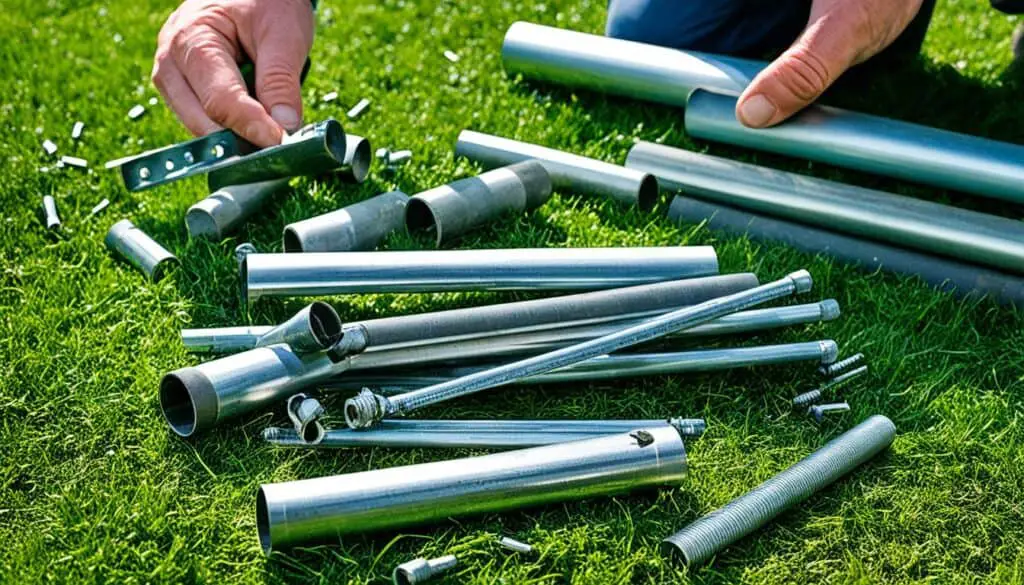Are you tired of searching for the perfect hammock stand that suits your specific needs and style? Why not take matters into your own hands and build your own DIY hammock stand? With our easy-to-follow guide, you’ll be able to create a personalized and durable outdoor oasis that is perfect for relaxing and unwinding. So, are you ready to embark on your DIY adventure and enjoy countless hours of hammock bliss?
Key Takeaways:
- Building your own DIY hammock stand allows for customization and personalization.
- DIY hammock stands can be more cost-effective compared to store-bought options.
- Before starting your DIY project, gather all the necessary materials and tools.
- Accurate cuts and secure attachments are important for a sturdy and well-built hammock stand.
- Adding feet, supports, and eye screws enhances the stability and functionality of your homemade hammock stand.
Why Build a DIY Hammock Stand?
Building a DIY hammock stand has several advantages compared to purchasing one. By creating your own homemade hammock stand, you have the opportunity to customize the size, style, and materials used to suit your specific needs and preferences. Additionally, DIY hammock stands can often be more cost-effective than store-bought options, saving you money while still providing a high-quality and durable outdoor hammock stand.
Materials and Tools Needed
Before you start building your DIY hammock stand, make sure you have all the necessary materials and tools at hand. Here’s a list of what you’ll need:
Materials:
- Pressure-treated lumber
- Galvanized screws
- Eye screws
- Wood glue
- Concrete mix (if needed for stability)
Tools:
- Miter saw or circular saw
- Drill
- Screwdriver
- Tape measure
- Pencil or marker
- Level
- Clamps
- Safety goggles
- Gloves
Having these materials and tools ready will ensure a smooth and efficient building process. Remember to prioritize safety by wearing goggles and gloves when working with power tools. Now that you’re equipped, let’s move on to the next steps of creating your own DIY hammock stand.
“Having these materials and tools ready will ensure a smooth and efficient building process.”
Step 1: Cut Your Boards to Length
The first step in building your DIY hammock stand is to cut your boards to the appropriate lengths. Refer to your chosen hammock stand plans for specific measurements. Accurate and precise cuts are crucial for a sturdy and well-built hammock stand.
Using either a miter saw or circular saw, carefully cut the boards according to the dimensions provided in your plans. Take your time to ensure that each cut is accurate and aligns with the required measurements.
Avoid rushing through this step, as the quality of your cuts will have a direct impact on the overall stability and strength of your homemade hammock stand.
Ensure that all boards are cut to the correct lengths, as specified in your selected hammock stand plans. Double-check each cut before moving on to the next step to avoid any errors or discrepancies.
Why Accurate and Precise Cuts Matter
Accurate and precise cuts play a significant role in the construction of your DIY hammock stand. Here are a few reasons why:
- Structural Integrity: Precise cuts ensure that the boards fit together perfectly, providing a sturdy and stable foundation for your hammock stand.
- Balance and Alignment: Properly cut boards guarantee that the stand is balanced and aligned, preventing any wobbling or tilting when in use.
- Aesthetics: Clean cuts contribute to the overall appearance of your hammock stand, giving it a professional and polished look.
Remember, measure twice, cut once. Taking the time to accurately cut your boards will save you from potential rework or adjustments down the line.
Step 2: Assemble the Arms
Now that your boards have been cut to the appropriate lengths, it’s time to assemble the arms of your DIY hammock stand. This step is crucial in creating a sturdy and durable homemade hammock stand that will provide hours of relaxation in your outdoor space.
Follow the detailed instructions provided in your hammock stand plans to ensure proper positioning and attachment of the boards. Pay close attention to the specifications in the plans to achieve a strong and stable connection between the boards.
For secure and reliable assembly, it is recommended to use screws specifically designed for this purpose, such as Timberlok screws. These screws will securely sandwich the boards together, creating the arms of your hammock stand.
Remember to tighten the screws adequately to ensure a solid and stable structure. A well-assembled arm will contribute to the overall stability and longevity of your DIY hammock stand.
Expert Tip:
Before attaching the boards, double-check the alignment and make any necessary adjustments. It’s essential to have perfectly aligned boards for optimal stability and balance.
Once you have successfully assembled the arms, you are one step closer to enjoying your homemade hammock stand. The next step will involve constructing the frame, which will provide the foundation for your hammock stand. Stay tuned for the detailed instructions in the next section!
Step 3: Assemble the Frame
After assembling the arms of your DIY hammock stand, the next crucial step is to construct the frame. This step is essential in providing the necessary support and stability for your hammock. Fortunately, with the help of your chosen hammock stand plans, you’ll be able to navigate through this process seamlessly.
The frame serves as the backbone of your hammock stand, holding everything together securely. It’s important to reference the detailed instructions or color-coded diagram provided in your hammock stand plans before proceeding with assembly.
To construct the frame, you’ll need to use screws, particularly 4.5″ Timberlok screws, to attach the various components together. These screws offer reliable support and ensure that the frame remains sturdy throughout use.
By taking the time to carefully follow your plans, you can achieve a well-balanced frame that guarantees the longevity and durability of your DIY hammock stand. Maintaining precision during this stage will also contribute to the overall aesthetic appeal of your creation.
Remember, creating a solid and secure frame is vital in ensuring a safe and enjoyable hammock experience. So let’s move on to the next step and continue building your dream DIY hammock stand!

Step 4: Add the Feet
To provide stability and balance to your DIY hammock stand, it is important to add feet. Flip over the frame and carefully position and attach the feet to the underside of the frame. Ensure that the feet are centered and securely fastened using screws or other appropriate fasteners. The addition of feet is crucial for the proper function and safety of your homemade hammock stand.
Adding feet to your DIY hammock stand helps distribute weight evenly and prevent tipping or rocking. By securely fastening the feet to the frame, you can ensure the stability and balance required for a safe and enjoyable hammock experience. Make sure the feet are centered and aligned properly to maintain the structural integrity of your homemade hammock stand.
Step 5: Add the Supports
Adding supports to your DIY hammock stand is an essential step to ensure stability and strength. Properly installing supports will enhance the overall structure of your homemade hammock stand and contribute to its load-bearing capacity.
To add the supports, follow these steps:
- Find a suitable angle for the supports that will provide maximum support and balance.
- Attach the supports to the frame, making sure to maintain symmetry on both sides. Use screws or other appropriate fasteners to secure the supports firmly in place.
- Double-check that the supports are securely attached and aligned correctly with the frame.
By taking the time to properly install the supports, you’ll create a secure and reliable hammock stand. This step is crucial for ensuring the long-lasting enjoyment and safety of your DIY hammock stand.
Quote:
“The supports are like the backbone of your DIY hammock stand, providing the necessary stability and strength for a truly relaxing experience.”
With the supports in place, your DIY hammock stand is now one step closer to completion. The next section will guide you through the process of adding the final touches to your homemade hammock stand.
Step 6: Add the Eye Screws
Attaching your hammock to the stand requires the use of eye screws. Follow these steps to securely attach your hammock:
- Pre-drill holes in the appropriate locations on the hammock stand where you will attach the eye screws.
- Use stainless steel eye screws for optimal durability and strength.
- Screw the eye screws into the pre-drilled holes, ensuring a secure and stable attachment.
Proper installation of the eye screws is crucial for a safe and enjoyable hammock experience. The use of stainless steel eye screws ensures resistance to rust and corrosion, providing long-lasting support for your hammock.
Tips for Attaching Eye Screws
Here are a few tips to keep in mind when installing eye screws:
- Ensure that the eye screws are positioned correctly, allowing for an even distribution of weight when the hammock is in use.
- Always pre-drill holes slightly smaller than the diameter of the eye screws to ensure a snug fit and prevent splitting or cracking of the wood.
- Hand tighten the eye screws to avoid over-tightening, which could damage the wood or compromise the stability of the attachment.
Step 7: Move Into Place
Now that your DIY hammock stand is fully assembled, it’s time to find the perfect spot in your backyard or outdoor space to set it up. Look for a location that offers both comfort and relaxation, allowing you to fully enjoy your hammock.
Before placing your outdoor hammock stand, make sure that the ground is level and stable. This will ensure the stability and safety of your DIY creation.
Once you have found the ideal spot and checked the stability of the ground, carefully position and adjust your hammock stand. Take the time to ensure that it is situated in a way that allows for optimal comfort and relaxation. After all, the whole point of having a hammock stand is to unwind and enjoy the outdoors.
Congratulations! Your DIY hammock stand is now ready to be enjoyed. Get ready to embrace the tranquility and serenity of your outdoor space, and let the gentle swaying of your hammock whisk you away to a state of pure relaxation.
Additional Tips:
- Consider adding a hammock or hammock chair that complements your style and preferences.
- If your outdoor space is limited, explore portable hammock stand options that allow you to easily move and set up your hammock wherever you desire.
- Add shade or decorative elements such as fairy lights to create a cozy and inviting atmosphere around your hammock stand.
- Regularly inspect and maintain your DIY hammock stand to ensure its longevity and performance.
Benefits:
By building your own outdoor hammock stand, you not only save money but also have the opportunity to customize its design and dimensions to perfectly fit your needs. Additionally, having a dedicated space for your hammock enhances the aesthetics of your outdoor area and provides a relaxing oasis where you can unwind and recharge.
Additional Tips and Ideas
Building a DIY hammock stand allows for creativity and customization. Consider the following additional tips and ideas to enhance your homemade hammock stand:
- Add Decorative Elements: Personalize your hammock stand by adding decorative touches such as paint, stain, or colorful accessories. This allows you to match your hammock stand to your outdoor decor and create a visually appealing backyard oasis.
- Include Storage Features: Make your hammock stand more functional by incorporating storage solutions. Attach hooks or shelves to hold books, drinks, or other essentials, ensuring everything is within reach while you relax.
- Optimize Portability: If you want the flexibility to move your hammock stand around your yard or take it with you on camping trips, consider adding wheels or making it easily collapsible. This way, you can enjoy your hammock wherever you go.
- Experiment with Hammock Styles: While building your own hammock stand, take the opportunity to explore different types of hammocks. Whether it’s a traditional rope hammock, a comfortable fabric hammock, or a cozy hammock chair, choose the style that best suits your relaxation preferences.
- Add a Canopy or Shade: Protect yourself from direct sunlight or light rain by incorporating a canopy or shade structure into your hammock stand design. This will allow you to enjoy your hammock even on hot summer days or during unexpected weather changes.
Remember, the possibilities are endless when it comes to building your own DIY hammock stand. Let your imagination guide you and create a one-of-a-kind outdoor sanctuary that provides both comfort and style.
With these additional tips and ideas, you can elevate your DIY hammock stand to another level, making it not just a functional piece but also a statement of your personal taste and creativity.
| Tips | Ideas |
|---|---|
| 1. Add Decorative Elements | 1. Experiment with Hammock Styles |
| 2. Include Storage Features | 2. Add a Canopy or Shade |
| 3. Optimize Portability |
Tip: Optimize Portability
If you want the flexibility to move your hammock stand around your yard or take it with you on camping trips, consider optimizing its portability. Adding wheels or making it easily collapsible can make transportation and storage hassle-free.
By incorporating these tips and ideas into your DIY hammock stand project, you can create a unique and functional outdoor oasis that brings both relaxation and style to your backyard.
Benefits of DIY Hammock Stands
In addition to the joy of crafting your own outdoor oasis, building a DIY hammock stand offers several benefits:
1. Customization
When you build your own hammock stand, you have the freedom to customize it according to your preferences and needs. You can adjust the dimensions, choose the materials, and even add unique features to make it truly your own. Whether you want a rustic wooden stand or a sleek metal design, the possibilities are endless.
2. Cost Savings
Creating a DIY hammock stand is often more cost-effective than purchasing a pre-made one. By selecting affordable materials and utilizing your creative skills, you can save money while still enjoying a high-quality outdoor hammock stand. Plus, you can repurpose leftover materials from other projects, further reducing the overall cost.
3. Sense of Accomplishment
Building a DIY hammock stand is a rewarding experience. As you see your project come together, you’ll feel a sense of satisfaction and pride in your craftsmanship. It’s a tangible representation of your hard work and creativity, providing a lasting source of pride and enjoyment.
4. Personalized Design
With a DIY hammock stand, you have the opportunity to create a design that perfectly fits your style and aesthetic preferences. Whether you prefer a minimalist look or vibrant colors, you can tailor the design to match your outdoor space’s theme. Express your personality and create a stand that reflects your unique taste.
5. Enhanced Durability
When you build your own hammock stand, you have full control over the quality of materials used. By selecting sturdy and durable materials, you can ensure that your stand will withstand the elements and provide years of reliable use. This allows you to enjoy countless hours of relaxation without worrying about wear and tear.
6. Tailored Stability
By building your own DIY hammock stand, you can customize its stability based on your specific environment. Whether you need to navigate uneven terrain or prefer extra stability in windy conditions, you can modify the design to meet your requirements. This ensures a secure and comfortable hammock experience.
Overall, building a DIY hammock stand allows you to create a personalized, durable, and cost-effective outdoor retreat. Enjoy the satisfaction of crafting your own stand and relax in comfort and style.
Safety Considerations
While building your own DIY hammock stand can be an enjoyable and rewarding project, it’s crucial to prioritize safety throughout the process. Follow these key safety considerations to ensure a secure and hazard-free outdoor hammock stand:
1. Location, location, location
Choose a stable and level area in your backyard or outdoor space to set up your DIY hammock stand. Avoid uneven or sloping terrain that could compromise its stability.
2. Check the weight capacity
Before relaxing on your hammock, verify that your DIY hammock stand can safely support your weight. Refer to the manufacturer’s guidelines or consult the plans to determine its maximum weight capacity. Overloading the stand can lead to structural damage and potential accidents.
3. Reinforce the connections
Regularly inspect the connections and joints of your DIY hammock stand. Ensure that all screws or fasteners are securely tightened to prevent wobbling or disassembly while in use.
4. Quality materials
Choose high-quality materials for the construction of your outdoor hammock stand. Opt for sturdy and durable wood or metal that can withstand external elements, such as rain, wind, and sun exposure.
5. Weather protection
Consider applying weather-resistant treatment or sealant to the surface of your DIY hammock stand. Protecting the stand against moisture, rot, and other weather conditions will extend its lifespan and maintain its structural integrity.
6. Inspect for damage
Regularly inspect your DIY hammock stand for any signs of damage, such as cracks, splinters, or weakened joints. Address any issues promptly by repairing or replacing the affected components to ensure continued safety.
Always prioritize safety when building and using your homemade hammock stand. By following these safety considerations, you can enjoy countless hours of relaxation and serenity in a secure and stable outdoor hammock stand.

Safety Checklist
| Safety Considerations | Actions |
|---|---|
| Choose a suitable location | Ensure stability and level ground |
| Check weight capacity | Refer to manufacturer’s guidelines |
| Reinforce connections | Tighten screws and fasteners regularly |
| Use quality materials | Opt for durable wood or metal |
| Apply weather protection | Seal or treat the surface |
| Inspect for damage | Repair or replace compromised components |
Maintenance and Care
Proper maintenance and care are crucial for ensuring the longevity and optimal performance of your DIY hammock stand. By following these guidelines, you can extend the lifespan of your wooden or metal hammock stand and continue to enjoy its comfort and relaxation for years to come.
Cleaning and Inspection
Regular cleaning and inspection are essential maintenance tasks for your DIY hammock stand. Remove any dirt, leaves, or debris that may accumulate on the stand using a soft brush or cloth. Inspect the stand for any signs of wear, damage, or loose components. Tighten any loose screws or connections, and replace any worn or damaged parts promptly.
Protective Coating
If you have a wooden hammock stand, applying a protective coating can help prevent weathering and extend its lifespan. Before applying any coating, ensure the wood is clean and dry. Choose a suitable outdoor wood sealant or stain and carefully follow the manufacturer’s instructions for application.
Storage
Proper storage is essential, especially during inclement weather or extended periods of non-use. If possible, dismantle your DIY hammock stand and store it in a dry and sheltered area, such as a garage or shed. This will protect the stand from harsh weather conditions and prolong its durability.
Seasonal Considerations
Depending on your location and climate, you may need to take additional precautions during certain seasons. For example, if you live in an area with severe winters, consider storing your hammock stand indoors or utilizing a weatherproof cover to protect it from ice, snow, and freezing temperatures.
Regular Inspections
Make it a habit to inspect your DIY hammock stand regularly, especially before each use. Check for any loose connections, signs of wear, or structural damage. By addressing any issues promptly, you can ensure the safety and longevity of your hammock stand.
Maintenance Tips Comparison
| Wooden Hammock Stand | Metal Hammock Stand |
|---|---|
| Requires protective coating to prevent weathering | Resistant to weather without additional coatings |
| May require more frequent inspections and maintenance | Generally low maintenance |
| Susceptible to moisture and insect damage | Durable and less prone to damage |
| Store in a dry and sheltered area during winter | Can withstand most weather conditions |
By following these maintenance and care tips, you can ensure that your DIY hammock stand remains sturdy, safe, and in excellent condition throughout its lifespan. Regular inspections and proactive maintenance will help you avoid costly repairs or replacements, allowing you to fully enjoy your outdoor oasis.
Conclusion
Building your own DIY hammock stand is a rewarding project that will enhance your relaxation experience in your outdoor space. By following our easy-to-follow guide, you can create a personalized and durable hammock stand that perfectly suits your needs and style. Whether you opt for a wooden or metal design, the satisfaction of crafting your own portable hammock stand is unmatched.
So gather your materials, tools, and enthusiasm, and embark on this exciting DIY adventure to create the perfect homemade hammock stand for your outdoor oasis. With a DIY hammock stand, you have the freedom to customize every aspect to meet your preferences and ensure a comfortable and secure hammock experience.
Don’t wait any longer! Start your DIY journey today and enjoy the countless hours of relaxation and enjoyment that your homemade hammock stand will provide. Say goodbye to generic store-bought options and revel in the pride of having a one-of-a-kind portable hammock stand that you built with your own hands. Begin assembling your DIY hammock stand and bask in the tranquility of your outdoor haven.
FAQ
What are the benefits of building a DIY hammock stand?
Building a DIY hammock stand allows for customization to meet your specific needs and design preferences. It can also be more cost-effective than purchasing a pre-made stand.
What materials and tools do I need to build a DIY hammock stand?
You will need boards, screws, a saw (such as a miter saw or circular saw), and eye screws for attaching the hammock.
How do I cut the boards for a DIY hammock stand?
Consult your chosen hammock stand plans for specific measurements, then use a saw to carefully cut the boards to the appropriate lengths.
How do I assemble the arms of a DIY hammock stand?
Follow the instructions provided in your hammock stand plans to position and attach the boards together, using screws for a secure connection.
How do I assemble the frame of a DIY hammock stand?
Refer to your chosen hammock stand plans for instructions on how to properly assemble the frame, using screws to attach the components together.
How do I add feet to a DIY hammock stand?
Flip over the frame and attach feet to the underside, ensuring they are centered and securely fastened using screws or other appropriate fasteners.
How do I add supports to a DIY hammock stand?
Find a suitable angle and attach the supports to the frame, maintaining symmetry on both sides for stability and load-bearing capacity.
How do I attach the hammock to a DIY hammock stand?
Pre-drill holes in the appropriate locations and use stainless steel eye screws to attach the hammock securely to the stand.
How do I move a DIY hammock stand into place?
Find a suitable location, ensure the ground is level and stable, and carefully position and adjust the hammock stand for optimal comfort.
Are there any additional tips and ideas for a DIY hammock stand?
Consider adding accessories like cup holders or a canopy for added comfort. Get creative with paint or stain for a personalized look.
What are the benefits of DIY hammock stands?
DIY hammock stands can be customized to meet your specific needs and design preferences, and can often be more cost-effective than store-bought options.
What safety considerations should I keep in mind when building a DIY hammock stand?
Ensure proper stability and weight-bearing capacity, place the stand on stable ground, and regularly inspect the stand for any signs of wear or damage.
How should I maintain and care for my DIY hammock stand?
Keep the stand clean and free from dirt and debris, regularly check for any loose or damaged components, and store the stand in a dry and covered area when not in use.











